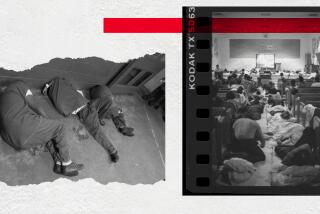Latest in Incarceration Outdoes Alcatraz : Prisons: Super Max facility about to open in Colorado will house the very worst federal convicts, the kind once sent to island in San Francisco Bay. There’ll be no coddling here.
- Share via
FLORENCE, Colo. — “An uncommon level of security.” That’s the understated way wardens describe the “new Alcatraz” that soon will welcome the nation’s most violent, incorrigible federal prisoners.
The $60-million U.S. Penitentiary Administrative Maximum Facility will open in this southern Colorado community of 3,500 in a matter of days. It’s the first federal prison ever built just for the most predatory inmates in the U.S. Bureau of Prisons. Nearly 500 of them will be sent here.
Alcatraz on an island in San Francisco Bay was the home of their sort in years past. Then a federal penitentiary in Marion, Ill., was modified for the purpose. Now comes Super Max.
“There’s no doubt this is a severe program,” said John Vanyur, the prison’s associate warden. “This is not a typical prison facility. It’s one of a kind. And it’s only used for this very small number of people.”
There are motion detectors in underground crawl spaces, 1,400 remote-controlled sliding steel doors, cameras covering virtually every nook and cranny, and 12-foot chain-link fences topped with razor wire.
The 7-feet-by-12-feet cells could be described as Spartan. They contain a polished steel mirror (glass is a weapon) riveted to the solid concrete wall. The toilet and shower are steel and fixed to the walls, the bed is a slab of concrete covered with a mattress. The only other place to sit is an immovable concrete cylinder in front of a writing table, also concrete.
Cells are designed so inmates cannot make eye contact with other prisoners, or see anything outside except the prison walls and the Colorado sky.
The worst inmates will be cell-bound 23 hours a day, five days a week. Those five days, they get an hour of solitary exercise in a cement-walled room; the other two days, they don’t get any exercise, period.
In their cells, they will receive educational programming on a 12-inch black-and-white television, their meals on trays and their showers, with the water controlled from the outside. Inmates needing counseling from ministers or social workers will get it in their cells.
Inmates will be sent here from Marion and other federal prisons. Prison officials are not allowed to discuss who will call Super Max home, but they can generalize.
“They’ve demonstrated through highly assaultive behavior, predatory behavior and escape-related behavior that they cannot function in a less-secure prison,” said Louis Winn Jr., an executive assistant. “They’ve proven themselves to be extremely dangerous and violent.”
Forty-four percent of Marion’s prisoners have committed murder or at least tried, Winn says. While many inmates sent to Super Max will be serving life sentences, it will not be their home for life. Officials expect inmates to stay no longer than three years before returning to the relative freedoms of ordinary federal prisons.
During their time at Super Max, they will be kept on short leashes and monitored constantly.
If inmates have to see doctors or dentists, they will walk only a couple of dozen paces and two correctional officers will accompany them, Winn says. One will walk in front with a baton, the only weapon allowed inside the prison, and one will walk behind, holding the chains connected to handcuffs the prisoner will be wearing behind his back.
Inmates are allowed up to three paperbacks to read, but no law books (only copies of applicable pages) so no contraband can be smuggled. Visitors remain beyond inch-thick plate-glass designed to withstand hammer blows.
If an inmate participates in rehabilitation programs and stays out of trouble, his confinement can be modified so he can mingle with other inmates and visit the commissary.
“Buildings are only one part of the program,” Vanyur said. “The key part is what the staff do and how they interact. They’re the ones who have to preserve self-esteem and humanity issues--maintaining dignity but getting across the message.
“You go back to the Alcatraz example. . . . You all had the same haircut, walked in lock-step down the hallway and didn’t speak during meals. Those elements of dehumanization, we don’t have that here. Every individual has his own program. Caseworkers, psychologists and chaplains are going to come down and deal with him.”
But the security measures go on and on and on.
Plumbing has automatic shut-offs so inmates cannot flood cells. Sprinklers and smoke containment systems are built in. Matches and cigarette lighters are forbidden. Smokers must use a lighter built into each cell wall.
Handles on toothbrushes are cut off to prevent use as weapons. Only pencil stubs are allowed. Pictures of spouses (no nudity) are allowed, but frames are not.
Escape-minded inmates will have their hopes dashed. Between their cells and freedom lie seven layers of secured steel and cement. Beneath the building is a crawl space with no outlet, monitored by the motion detectors.
The prison is surrounded by cleared landscape, those 12-foot fences and razor wire, and six towers occupied by armed guards. Guy wires will be strung over open areas to prevent helicopter escapes. In addition, there are other security systems federal officers would rather not have prisoners know about and will not discuss.
“There’s obviously a message here and the message is ‘We’re not going to tolerate your violent behavior or predatory behavior, and in fact if you change that behavior you eventually will get more privileges,’ ” Vanyur said.
More to Read
Sign up for Essential California
The most important California stories and recommendations in your inbox every morning.
You may occasionally receive promotional content from the Los Angeles Times.












